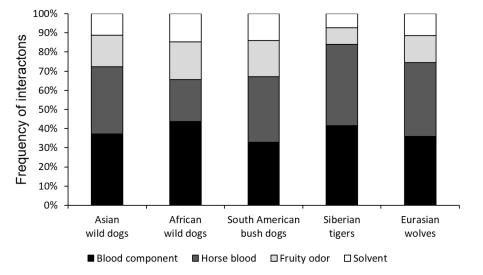Discussion
Group 1
The overall weak interest in the odorized logs for the wolves in group 1 could be explained by a general suspiciousness towards novel objects or situations in this group. According to the wolf caretakers, this group of wolves is particularly anxious overall. It is unlikely that the relevance of the odor stimuli was the cause of the avoidance behavior expressed by the wolves, as objects cannot be avoided out of sheer disinterest or lack of perceived relevance. As most of the wolves in group 1 avoided to encounter the logs, that is, they took a detour around the logs instead of just walk by, it is likely that the wolves were experiencing neophobia.
Group 2
The wolves in group 2 displayed a significantly higher number of interactions with the odorized logs when presented with the blood component and the horse blood compared to the fruity odor and the solvent. This demonstrates that the wolves were more interested in these prey-associated odors compared to the two non-prey-associated odors. It further suggests that these wolves may perceive trans-4,5-epoxy-(E)-2-decenal as blood-like, similar to humans.
Enrichment
As the wolves in group 2 spent a lot of time investigating the odorized logs, displaying a lot of different natural behaviors, the setup can be considered as enriching for the animals. This was especielly true when using prey-associated odors.
Habituation to environmental enrichments can sometimes be a problem. However, in my study, the wolves did not display any decrease in the number of interactions over time. This indicates that odorized logs can be used as efficient environmental enrichment under longer periods of time in this species, particularly if the odors are presented in a pseudorandomized order as was the case in this study.
The odorized logs in my study were also both cheap, hygienic and easy to handle and exchange, and did not require much time for preparation. I therefore conclude that odorized logs are a suitable environmental enrichment tool for captive wolves.
Comparisons between previously studied species
All five species showed greatest interest in the blood odor and/or the blood odor component. These results further strengthen the interpretation that the odor of trans-4,5-epoxy-(E)-2-decenal is perceived as “blood-like” by these carnivore species.

In humans, the odors of some foods have been shown to be characterized by so called “key compounds” or “character-impact compounds”. As the blood component was at least as interesting as the whole chemical mixture of blood, for all five carnivore species, the blood component trans-4,5-epoxy-(E)-2-decenal might indeed be a "key compound" of the odor of blood not only for humans but also for nonhuman mammals.
Responsible for this page:
Director of undergraduate studies Biology
Last updated:
05/03/16
